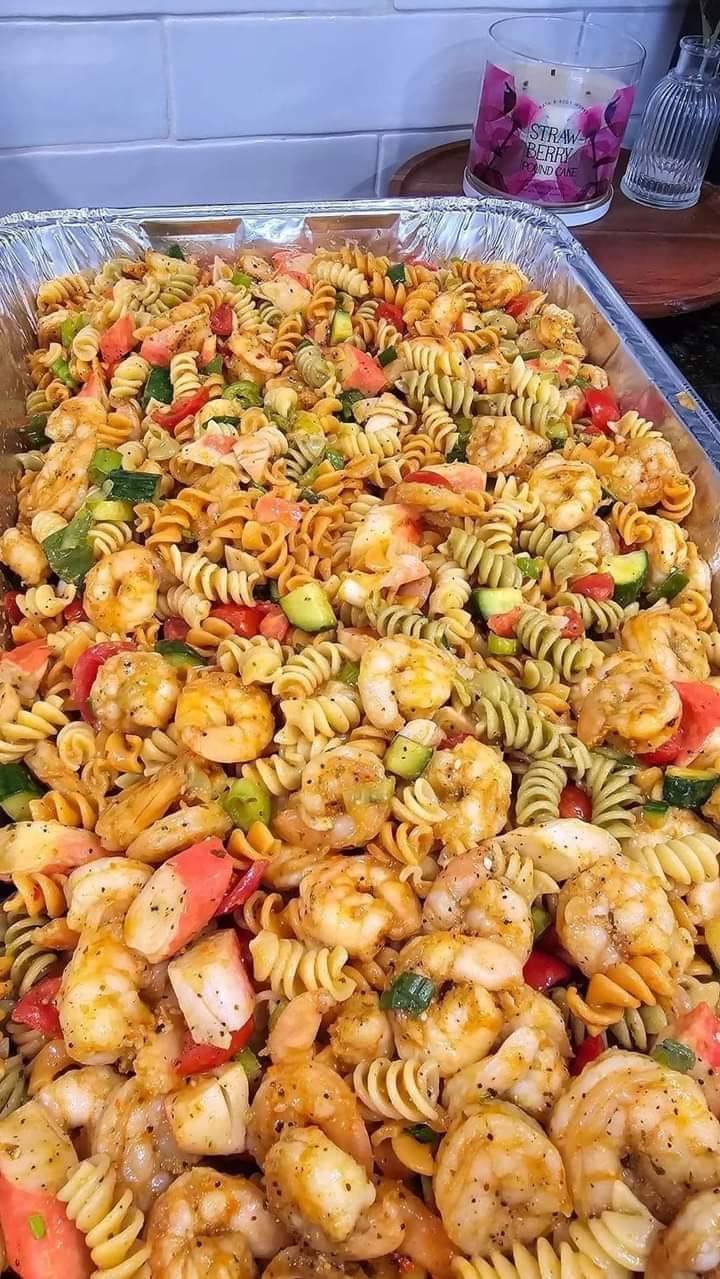Pasta salad is a versatile and refreshing dish made with pasta, fresh vegetables, and cheese, all tossed in a flavorful dressing. It’s perfect for gatherings and can be customized with various ingredients to suit different tastes.
Pasta Salad
Ingredients:
3 boxes tri-color rotini
3 small cucumbers
2 bags of large raw shrimp
3 packs of crab meat
1 bunch of green onions
1 pack cherry tomatoes
1 bottle olive garden Italian dressing
- When all ingredients are combined season with salad supreme.
- season shrimp with old bay and complete season. Cook your shrimp in 1 stick of butter until done.
Variations:
- Mediterranean Pasta Salad: Add olives, feta cheese, cherry tomatoes, cucumbers, and red onions, and dress with olive oil, lemon juice, and oregano.
- Italian Pasta Salad: Mix in pepperoni, mozzarella balls, cherry tomatoes, black olives, and bell peppers. Use an Italian dressing.
- Greek Pasta Salad: Include Kalamata olives, feta cheese, cucumbers, tomatoes, and red onions. Season with a Greek vinaigrette.
- Southwestern Pasta Salad: Combine black beans, corn, diced bell peppers, and avocado. Use a cilantro-lime dressing.
- Chicken Pasta Salad: Add cooked, shredded chicken along with your favorite vegetables and a creamy or vinaigrette-based dressing.
Tips:
- Cook Pasta Al Dente: To avoid mushy pasta, cook it just until tender but still firm to the bite.
- Rinse Pasta: After cooking, rinse the pasta under cold water to stop the cooking process and cool it quickly.
- Season Well: Taste and adjust seasoning after mixing in the dressing to ensure it’s flavorful.
- Chill Before Serving: Let the salad sit in the refrigerator for at least 30 minutes to let the flavors meld together.
- Add Dressing Just Before Serving: If making ahead, add the dressing just before serving to prevent the pasta from becoming too soggy.
To store pasta salad properly:
- Cool Before Storing: Allow the pasta salad to cool to room temperature before refrigerating to avoid raising the temperature inside the fridge.
- Use an Airtight Container: Transfer the pasta salad into an airtight container to keep it fresh and prevent it from absorbing other odors in the fridge.
- Refrigerate Promptly: Store the pasta salad in the refrigerator as soon as possible. It should be kept at a temperature of 40°F (4°C) or lower.
- Consume Within 3-5 Days: For best quality, eat the pasta salad within 3-5 days. If you notice any signs of spoilage like off smells or changes in texture, discard it.
- Add Dressing Just Before Serving: If you anticipate storing leftovers, consider keeping the dressing separate and adding it just before serving to prevent the pasta from becoming too soggy.
The nutritional information for pasta salad can vary widely depending on the ingredients and dressing used. Here’s a general overview for a basic pasta salad (1 cup serving):
- Calories: Approximately 200-300 kcal
- Protein: 6-10 grams
- Carbohydrates: 30-40 grams
- Fat: 8-15 grams
- Saturated Fat: 1-3 grams
- Fiber: 2-4 grams
- Sugars: 2-5 grams
- Sodium: 200-500 mg
Factors that can influence the nutritional content:
- Pasta Type: Whole grain or high-fiber pasta will alter the nutrient profile compared to regular pasta.
- Dressings: Creamy dressings will increase the fat and calorie content, while vinaigrettes tend to be lighter.
- Add-ins: Ingredients like cheese, meats, and extra veggies can add protein, fats, and vitamins.
For accurate nutritional information, consider using a nutrition calculator with the specific ingredients and amounts used in your recipe.
